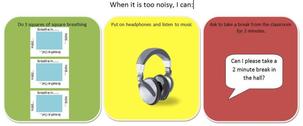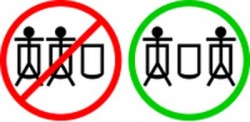Socially Appropriate Calming Behaviour
When children on the spectrum are overwhelmed, either in their sensory systems or socially or otherwise, we often see socially inappropriate behaviours that can make them stand out. We can help by using visuals to remind them of socially appropriate ways to help them calm themselves down.
Urinal Etiquette
It may seem comical, but in a field where we are a majority of women teaching a majority of boys, this type of rule can be important and perhaps something we don't think about. We can make simple visuals that help our kids understand social rules that will help them fit in, or at least not stand out. We might talk to each other in the washroom as women, but men don't - talk to the men in your life about relevant rules - have them really think about those rules that they typically don't think about. Those are the rules we have a responsibility to teach our kids, who don't pick them up on their own.
Wait Card
Waiting can be difficult, especially for children with receptive language difficulties who don't understand what waiting means. Use a wait card to make this a little more concrete. Practise during down time; give the child something to play with, then take it back after a minute, giving the wait card and saying "wait". Only do this for a quick second, before there is time for protest, then very quickly, take the card back, and give the toy back, praising for "good waiting". Next time, make it 2 or 3 seconds, then later 5, then 10, and so on, and the child will hopefully begin to learn that while he/she is holding the card, it means he is "waiting" and that holding the card means the thing he wants is coming soon. Sometimes, simply having that tangible 'ticket' to hold on to can help a child understand that waiting is not indefinite, and that something is coming soon. Even better, pair the card with a timer indicating how long the waiting will need to last.
Your browser does not support viewing this document. Click here to download the document.
|
Facial Expression Cards
These cards, brought to you by abcteach.com, can be used to teach how others may be feeling based on the major characteristics of their facial expression. Try using them with a mirror to show students that their own facial expressions give clues about how they are feeling as well.
More Facial Expression Cards
You may want to start very simple at first, perhaps beginning with happy and angry, then adding in sad, then the rest one at a time, focusing on pointing out examples of each emotion in the child and in others over the course of a few days or even a week until it is well understood.
Emotions - Photo Faces
Sometimes, children respond better to photographs. Here are some photographs demonstrating a variety of emotions. Feel free to change the wording (from "sadness" to "sad"). As always, do what works for you.
Degrees of Emotion
How happy ARE you? Within each emotion, there is a varying degree of that emotion. One might be a little happy, quite happy, or VERY happy. Distinguishing between these is an important social skill, and using pictures such as these can help teach the subtle differences between. Work together with your child to determine what those differences are, and then apply it to day to day situations you encounter. Use a mirror to look at his/her own varying facial expressions to tie them in with his emotions in the moment.
|
Proudly powered by Weebly